
The Nashville, Chattanooga and St. Louis Railway was a railway company that operated in the U.S. states of Kentucky, Tennessee, Alabama, and Georgia. It began as the Nashville and Chattanooga Railroad, chartered in Nashville on December 11, 1845, built to 5 ft gauge and was the first railway to operate in the state of Tennessee. By the turn of the twentieth century, the NC&StL grew into one of the most important railway systems in the southern United States.

The Louisville and Nashville Railroad, commonly called the L&N, was a Class I railroad that operated freight and passenger services in the southeast United States.

The Pan-American was a passenger train operated by the Louisville and Nashville Railroad (L&N) between Cincinnati, Ohio and New Orleans, Louisiana. It operated from 1921 until 1971. From 1921 to 1965 a section served Memphis, Tennessee via Bowling Green, Kentucky. The Pan-American was the L&N's flagship train until the introduction of the Humming Bird in 1946. Its name honored the substantial traffic the L&N carried to and from the seaports on the Gulf of Mexico. The Pan-American was one of many trains discontinued when Amtrak began operations in 1971.
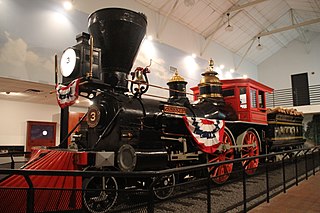
Western & Atlantic Railroad #3 General is a 4-4-0 "American" type steam locomotive built in 1855 by the Rogers, Ketchum & Grosvenor in Paterson, New Jersey for the Western & Atlantic Railroad, best known as the engine stolen by Union spies in the Great Locomotive Chase, an attempt to cripple the Confederate rail network during the American Civil War. Today, the locomotive is preserved at the Southern Museum of Civil War and Locomotive History in Kennesaw, Georgia, and is listed on the National Register of Historic Places.
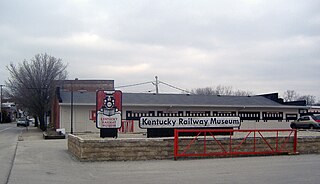
The Kentucky Railway Museum, now located in New Haven, Kentucky, United States, is a non-profit railroad museum dedicated to educating the public regarding the history and heritage of Kentucky's railroads and the people who built them. Originally created in 1954 in Louisville, Kentucky, the museum is at its third location, in extreme southern Nelson County. It is one of the oldest railroad stations in the United States.
The Memphis, Clarksville and Louisville Railroad (MC&L) was a railway in the southern United States. It was chartered in Tennessee in 1852, and opened in 1859. The MC&L entered receivership after the American Civil War, and financial troubles led to an 11-day strike in 1868 that ended when Louisville and Nashville Railroad (L&N) leased the line. L&N finally purchased the MC&L in 1871 and operated it as its Memphis Branch. L&N was merged into CSX, and CSX sold the former MC&L line to R.J. Corman Railroad Group in 1987, becoming that company's Memphis Line.

The Flim-Flam Man is a 1967 American comedy film directed by Irvin Kershner, featuring George C. Scott, Michael Sarrazin, and Sue Lyon, based on the 1965 novel The Ballad of the Flim-Flam Man by Guy Owen. The movie has well-known character actors in supporting roles, including Jack Albertson, Slim Pickens, Strother Martin, Harry Morgan, and Albert Salmi.

Birmingham station is a train station in Birmingham, Alabama. It is a service stop for Amtrak's Crescent, which provides daily service between New York City, Atlanta, and New Orleans. The current station is located on the site of another station originally built by the Louisville and Nashville Railroad in 1960, although Amtrak did not use the building itself, which was torn down in the 2000s.
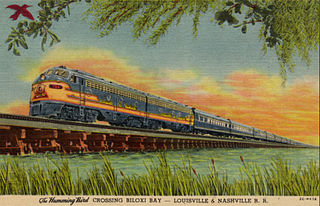
The Humming Bird was a named train of the Louisville and Nashville Railroad (L&N). The train, inaugurated in 1946, originally ran from Cincinnati, Ohio, to New Orleans, Louisiana, via Louisville, Nashville, Birmingham, Montgomery and Mobile and later via a connection at Bowling Green, Kentucky, to Memphis, Tennessee. A connection to Chicago was provided by the Chicago and Eastern Illinois Railroad.
The Louisville and Nashville Depot, or Louisville and Nashville Railroad Depot or Louisville and Nashville Passenger Station, Louisville and Nashville Railroad Passenger Depot or variations, may refer to the following former and active train stations previously used by the Louisville and Nashville Railroad. Some of these are listed on the National Register of Historic Places (NRHP).

The Historic Railpark and Train Museum, formerly the Louisville and Nashville Railroad Station in Bowling Green, Kentucky, is located in the historic railroad station. The building was placed on the National Register of Historic Places on December 18, 1979. Opened in 1925, the standing depot is the third Louisville & Nashville Railroad depot that served Bowling Green.
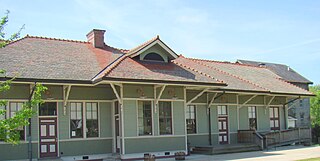
Stanford L&N Railroad Depot, also known as Baughman's Mill and Stanford Railroad Depot, is a historic train depot located in Stanford, Kentucky. It was built in 1911 and was used by the Louisville and Nashville Railroad.

The Bardstown station, also known as Old L & N Station, is a historic railroad station on the National Register of Historic Places in the northernmost section of the Bardstown Historic District of Bardstown, Kentucky. Long owned by the Louisville and Nashville Railroad (L&N), it is currently used as the station for the My Old Kentucky Dinner Train, owned by the R.J. Corman Railroad Group.

Louisville & Nashville 152 is a preserved K-2a class 4-6-2 "Pacific" type steam locomotive listed on the National Register of Historic Places, currently homed at the Kentucky Railway Museum at New Haven, Kentucky in southernmost Nelson County, Kentucky. It is the oldest known remaining 4-6-2 "Pacific" type locomotive to exist. It is also the "Official State Locomotive of Kentucky", designated as such on March 6, 2000. The locomotive is currently owned and being restored back to operating condition by the Kentucky Railway Museum.
The Mt. Broderick Pullman Car is a historic railcar on the National Register of Historic Places, currently at the Kentucky Railway Museum at New Haven, Kentucky, in southernmost Nelson County, Kentucky. It has been described as a "four-star hotel" on rails.
The Frankfort and Cincinnati Model 55 Rail Car is a historic railcar on the National Register of Historic Places. The railcar currently resides at the Kentucky Railway Museum in New Haven, Nelson County, Kentucky.
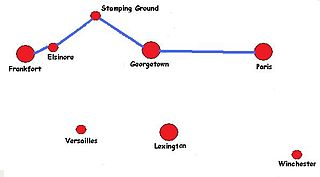
The Frankfort and Cincinnati Railroad is a defunct shortline railroad based in Kentucky. Despite its name, it had no connections with Cincinnati, Ohio.
The Glasgow Railway is an American short-line railroad whose line runs from Park City to Glasgow, Kentucky.

The Pensacola and Atlantic Railroad (P&A) was a company incorporated by an act of the Florida Legislature on March 4, 1881, to run from Pensacola to the Apalachicola River near Chattahoochee, a distance of about 160 miles (260 km). No railroad had ever been built across the sparsely populated panhandle of Florida, which left Pensacola isolated from the rest of the state. William D. Chipley and Frederick R. De Funiak, both of whom are commemorated in the names of towns later built along the P&A line, were among the founding officers of the railroad company.

The Dixie Flyer was a premier named American passenger train that operated from 1892 to 1965 via the "Dixie Route" from Chicago and St. Louis via Evansville, Nashville, and Atlanta to Florida. However, the train continued until 1969 as an Atlanta to Florida operation, run solely by the Atlantic Coast Line Railroad and its successor, the Seaboard Coast Line. The Flyer's route varied in early years, but by about 1920 was set as follows:

















